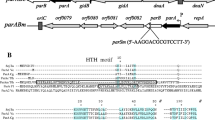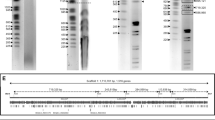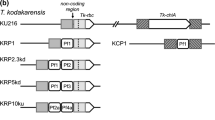Abstract
Two new linear plasmids, pK192L (4.9 kb) and pK192S (2.4 kb), were isolated from a Kluyveromyces lactis killer strain carrying pGKL1 and pGKL2. pK192L was a deletion plasmid of pGKL1, derived from a part of the ORF1, and had a palindrome structure of a 215 by unique sequence flanked by 2.35 by inverted repeats. pK192S was a hairpin plasmid produced by self-annealing of a single-stranded pK192L DNA. In genetic analysis, pK192L and pK192S always coexisted and replicated in cells harboring pGKL2 and pGKL1, in contrast to other pGKL1-derived deletion plasmids, such as F1, F2 and pGKLIS, which could replicate in cells carrying pGKL2 only. Based on these and other lines of evidence, it was concluded that the reason for the pGKL1 dependent replication of the pK192L/S plasmids was the absence of the intact pGKL1-ORF1 gene and that the ORF1 function was necessary for the replication of the pGKL1 genome. This finding is in good agreement with a recent view reporting that ORFI may encode a DNA polymerase of pGKL1. In a separate experiment, four new linear plasmids were isolated from a Saccharomyces cerevisiae strain carrying pGKL1 and pGKL2. Structural analysis showed that they consisted of two pairs of hairpin-palindrome type plasmids, each derived from different parts of pGKL2, respectively. pGKL1 stabily replicated in cells carrying both these pGKL2 derived deletion plasmids.
Similar content being viewed by others
References
Blanco L.and Salas M. (1985): Replication of phage Ø 29 DNA with purified terminal protein and DNA polymerase: synthesis of full-length Ø 29 DNA. -Proc. Natl. Acad. Sci. 82, 6404–6408.
Challberg M.D.and Kelly T.J. Jr. (1982): Eukaryotic DNA replication: viral and plasmid model systems.- Ann. Rev. Biochem. 51, 907–934.
Fukuhara H. (1987): The RF1 gene of the killer DNA of yeast may encode a DNA polymerase. -Nucleic Acids Res. 15, 10046.
Gunge N., Tamaru A., Ozawa F.and Sakaguchi K. (1981): Isolation and characterization of linear deoxyribonucleic acid plasmids from Kluyveromyces lactis and the plasmid-associated killer character. - J. Bacteriol. 145, 382–390.
Gunge N.andSakaguchi K. (1981): Intergeneric transfer of deoxyribonucleic acid killer plasmids, pGKL1 and pGKL2, from Kluyveromyces lactis into Saccharomyces cerevisiae by cell fusion. - J. Bacteriol. 147, 155–160.
Gunge N., Murata K.and Sakaguchi K. (1982): Transformation of Saccharomyces cerevisiae with linear DNA killer plasmids from Kluyveromyces lactis. - J. Bacteriol. 151, 462–464.
Gunge N. (1986): Linear DNA killer plasmids from the yeast Kluyveromyces. - Yeast 2, 153–162.
Hishinuma F., Nakamura K. Hirai K.Nishizawa R., Gunge N. and Maeda T. (1984): Cloning and nucleotide sequence of the linear DNA killer plasmids from yeast. - Nucleic Acids Res. 12, 7581–7597.
Jung G., Leavitt M.C. and Ito J. (1987): Yeast killer plasmid pGKLI encodes a DNA polymerase belonging to the family B DNA polymerases. -Nucleic Acids Res. 15, 9088.
Kikuchi Y., Hirai K. and Hishinuma F. (1984): The yeast linear DNA killer plasmids, pGKL1 and pGKL2, possess terminally attached proteins. -Nucleic Acids Res. 12, 5685–5692.
Kikuchi Y., Hirai K., Gunge N. and Hishinuma F. (1985): Hairpin plasmid-a novel linear DNA of perfect hairpin structure. - EMBO J. 4, 1881–1886.
Niwa O., Sakaguchi K. and Gunge N. (1981): Curing of the killer deoxyribonucleic acid plasmids of Kluyveromyces lactis. - J. Bacteriol. 148, 988–990.
Ostrove J.M., Rosenfeld P., Williams J. and Kelly T.J. (1983): In vitro complentation as an assay for purification of adenovirus DNA replication proteins. - Proc. Natl. Acad. Sci. 80, 935–939.
Sor F., Wesolowski M. and Fukuhara H. (1983): Inverted terminal repetitions of the two linear DNA associated with the killer character of the yeast Kluyveromyces lactis. - Nucleic Acids Res. 11, 5037–5044.
Sor F. and Fukuhara H. (1985): Structure of a linear plasmid of the yeast Kluyveromyces lactis: compact organization of the killer genome. - Curr. Genet. 9, 147–155.
Stam J.C., Kwakman J. Meijer M. and Stuitje A.R. (1987): Efficient isolation of the linear DNA killer plasmid of Kluyveromyces lactis: evidencer for location and expression in the cytoplasm and characterization of their terminally bound proteins. - Nucleic acid Res. 14, 6871–6884.
Stark M.J.R., Mileham A.J., Romanos M.A. and Boyd A. (1984): Nucleotide sequence and transcription analysis of a linear DNA plasmid associated with the killer character of the yeast Kluyveromyces lactis. - Nucleic Acids Res. 12, 6011–6030.
Stark M.J.R. and Boyd A. (1986): The killer toxin of Kluyveromyces lactis: characterization of the toxin subunits and identification of the genes which encode them. - EMBO J. 5, 1995–2002.
Sugisaki Y., Gunge N., Sakaguchi K., Yamasaki M. and Tamura G. (1983): Kluyveromyces lactis killer toxin inhibits adenylate cyclase of sensitive yeast cells. - Nature 304, 464–466.
Sugisaki Y., Gunge N., Sakaguchi K., Yamasaki M. and Tamura G.: Characterization of a novel killer toxin enconded by a double-stranded linear DNA plasmid of Kluyveromyces lactis.
Tamanoi F. and Stillman B.W. (1982): Function of adenovirus terminal protein in the initiation of DNA replication. - Proc. Natl. Acad. Sci. 79, 2221–2225.
Tipper D. and Bostiam K.A. (1984): Double-stranded ribonucleic acid killer systems in yeasts. -Microbiol. Rev. 48, 125–156.
Tokunaga T., Wada N. Hishinuma F. (1987): Expression and identification of immunity determinants on linear DNA killer plasmids pGKL1 and pGKL2 in Kluyveromyces lactis. -Nucleic acids Res. 15, 1031–1046.
Watabe K., Leusch M. and Ito J. (1984): Replication of bacteriophage Ø 29 DNA in vitro: the roles of terminal protein and DNA polymerase. - Proc. Natl. Acad. Sci. 81, 5374–5378.
Wesolowski M., Algeri A., Goffrini P. and Fukuhara H. (1982): Killer DNA plasmids of the yeast Kluyveromyces lactis. I. Mutations affecting the killer phenotype. - Curr. Genet. 5, 191–197 (1982).
Wesolowski-Louvel M., Tanguy-Rougeau C. and Fukuhara H. (1988): A nuclear gene required for the expression of the linear DNA-associated killer system in the yeast Kluyveromyces lactis. - Yeast 4, 71–81.
Wickner R.B. (1981): Killer system in Saccharomyces cerevisiae. In The Molecular Biology of the Yeast Saccharomyces cerevisiae: Life Cycle and Inheritance, J.N. Strathern, E.W. Jones, and J.R. Broach, eds Cold Spring Harbor Laboratory, Cold Spring Harbor, New York, pp. 415–444.
Yoshikawa H. and Ito J. (1981): Terminal proteins and short inverted terminal repeats of the small Bacillus bacteriophage genomes. - Proc. Natl. Acad. Sci. 78, 2596–2600.
Author information
Authors and Affiliations
Rights and permissions
About this article
Cite this article
Gunge, N., Kitada, K. Replication and maintenance of the Kluyveromyces linear pGKL plasmids. Eur J Epidemiol 4, 409–414 (1988). https://doi.org/10.1007/BF00146390
Issue Date:
DOI: https://doi.org/10.1007/BF00146390




